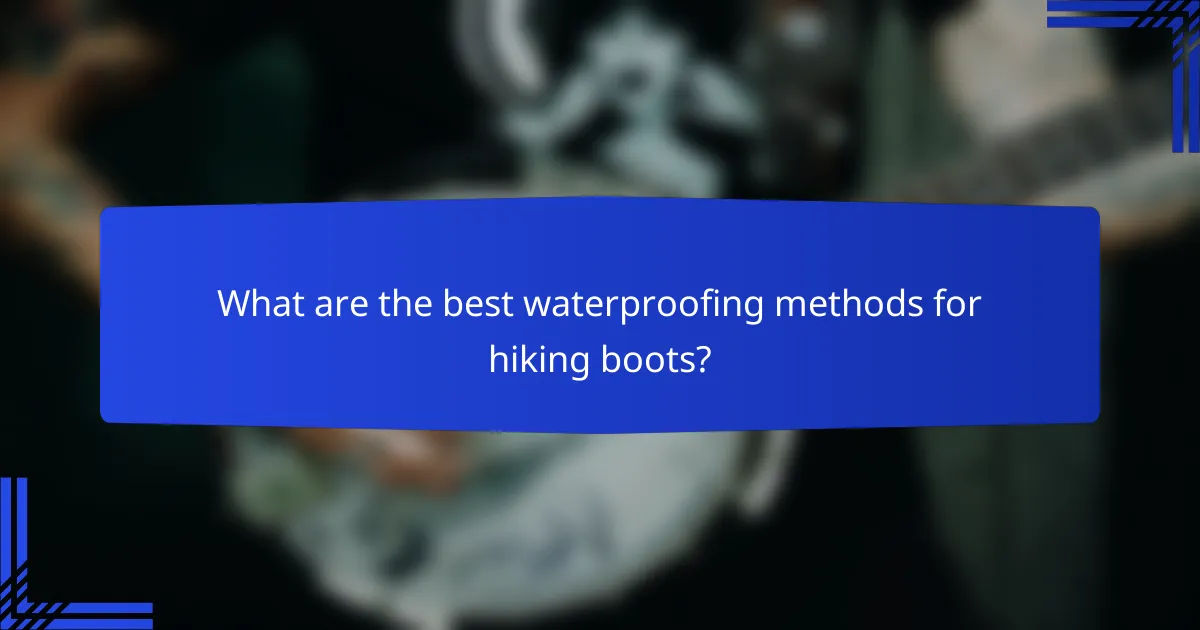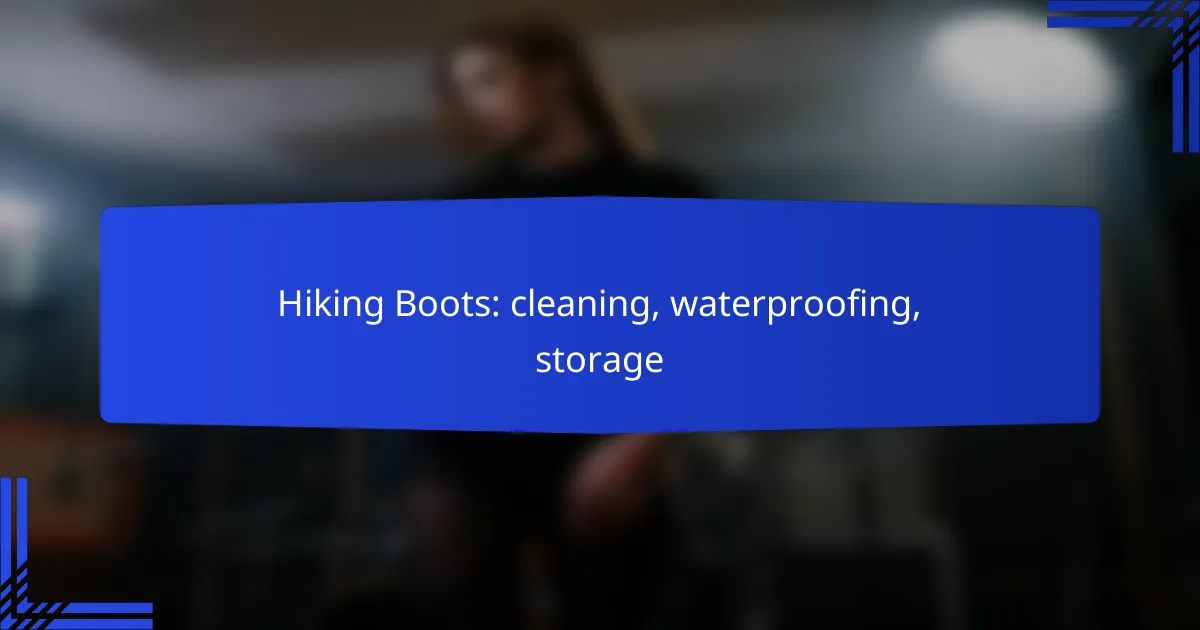Hiking boots are essential for any outdoor enthusiast, and maintaining them is crucial for optimal performance and longevity. Regular cleaning, effective waterproofing, and proper storage are key practices that ensure your boots remain in excellent condition, ready for your next adventure. By following these straightforward steps, you can protect your investment and enjoy many miles on the trail.

How to clean hiking boots effectively?
Cleaning hiking boots effectively involves a few straightforward steps to ensure they remain in good condition and perform well. Regular cleaning helps maintain their waterproofing and extends their lifespan.
Use warm water and mild soap
Start by filling a basin or bucket with warm water and adding a small amount of mild soap. Avoid harsh detergents, as they can damage the materials of your boots.
Using a soft cloth or sponge, gently scrub the exterior of your boots to remove dirt and grime. Rinse with clean water to ensure no soap residue remains, which could affect the boot’s performance.
Remove insoles and laces
Before cleaning, take out the insoles and laces from your hiking boots. This allows you to clean all areas thoroughly and prevents any damage to the laces during the washing process.
Insoles can be washed separately with warm soapy water. Ensure they are completely dry before reinserting them into the boots to avoid moisture buildup.
Brush off dirt and debris
Use a soft-bristled brush to remove any loose dirt and debris from the boots. Pay special attention to the seams and crevices where dirt tends to accumulate.
This step is crucial as it prepares the surface for deeper cleaning and helps prevent scratches during the washing process.
Air dry properly
After cleaning, allow your hiking boots to air dry in a well-ventilated area, away from direct sunlight and heat sources. Direct heat can warp the materials and compromise their integrity.
To maintain shape, stuff the boots with newspaper or a towel while drying. This helps absorb moisture and retain their form, ensuring they are ready for your next adventure.

What are the best waterproofing methods for hiking boots?
The best waterproofing methods for hiking boots include applying waterproof sprays, using wax or cream for leather boots, and checking for manufacturer recommendations. Each method has its own advantages and is suited to different types of materials and conditions.
Apply waterproof spray
Waterproof sprays are a convenient option for treating synthetic and fabric hiking boots. They create a protective barrier that repels water while allowing the material to breathe. Look for sprays specifically designed for outdoor footwear to ensure effectiveness.
To apply, clean your boots thoroughly and let them dry. Hold the spray can about 6-8 inches away and apply an even coat, focusing on seams and high-wear areas. Allow the boots to dry completely before using them, and reapply every few weeks or after heavy use.
Use wax or cream for leather boots
For leather hiking boots, using a waterproof wax or cream is essential to maintain their durability and water resistance. These products penetrate the leather, providing a moisture barrier and conditioning the material. Choose a product that matches your boot’s leather type for the best results.
Before applying wax or cream, clean the boots and let them dry. Use a soft cloth or sponge to apply a thin, even layer, ensuring you cover all areas, especially seams. Buff the boots after application for a polished finish, and reapply as needed, typically every few months or after exposure to wet conditions.
Check for manufacturer recommendations
Always consult the manufacturer’s recommendations for waterproofing your specific hiking boots. Different brands and models may have unique materials and coatings that require specific care. Following these guidelines can help maintain warranty coverage and ensure optimal performance.
Look for care instructions on the boot’s tag or the manufacturer’s website. Some brands may offer proprietary waterproofing products designed specifically for their footwear, which can provide the best protection and longevity.

How to store hiking boots to prolong their lifespan?
Proper storage of hiking boots is essential to extend their lifespan and maintain performance. By following a few simple guidelines, you can keep your boots in optimal condition for your next adventure.
Keep in a cool, dry place
Storing hiking boots in a cool, dry environment helps prevent moisture buildup and mold growth. Ideal storage temperatures are typically between 15°C and 25°C (59°F to 77°F). Avoid areas with high humidity or extreme temperature fluctuations.
If possible, use a dedicated storage space such as a closet or a shoe rack that is well-ventilated. This will protect your boots from dampness and ensure they remain dry and fresh.
Use boot trees or stuff with newspaper
Using boot trees or stuffing your hiking boots with newspaper helps maintain their shape and prevents creasing. Boot trees are specifically designed to fit inside boots, providing support and structure.
If you opt for newspaper, crumple it up and fill the boots to absorb any residual moisture. Replace the newspaper regularly to keep the interior dry and odor-free.
Avoid direct sunlight exposure
Direct sunlight can damage the materials of your hiking boots, leading to fading and deterioration. Store your boots in a shaded area or inside a box to protect them from UV rays.
When drying your boots after cleaning, avoid placing them in direct sunlight. Instead, let them air dry in a well-ventilated space away from heat sources to preserve their integrity.

What are the common mistakes in cleaning hiking boots?
Common mistakes in cleaning hiking boots include using inappropriate cleaning methods and neglecting essential maintenance steps. These errors can lead to damage, reduced performance, and a shorter lifespan for your footwear.
Using harsh chemicals
Harsh chemicals can damage the materials of hiking boots, such as leather and synthetic fabrics. Instead of using bleach or strong detergents, opt for mild soap and water to clean your boots effectively without causing harm.
Always check the manufacturer’s care instructions before applying any cleaning product. Some boots may require specific cleaners designed for their materials to maintain their integrity and performance.
Machine washing boots
Machine washing hiking boots can lead to structural damage and loss of waterproofing. The agitation and heat from the washing machine can warp the shape of the boots and weaken adhesives.
Instead of machine washing, clean your boots by hand using a soft brush and a damp cloth. This method allows for more control and minimizes the risk of damage.
Skipping waterproofing after cleaning
After cleaning, it’s crucial to reapply waterproofing treatments to maintain the boots’ water resistance. Cleaning can strip away existing waterproofing agents, leaving the boots vulnerable to moisture.
Use a suitable waterproofing spray or wax designed for your boot material. Regularly checking and reapplying waterproofing can extend the life of your hiking boots and keep your feet dry during outdoor activities.

What factors to consider when choosing hiking boots?
When choosing hiking boots, consider fit, material, and the type of terrain you will encounter. These factors significantly impact comfort, performance, and durability during your hikes.
Fit and comfort
Fit and comfort are crucial when selecting hiking boots, as an improper fit can lead to blisters and discomfort. Ensure there is enough room in the toe box, and that the heel is snug without slipping. Trying on boots with the socks you plan to wear can help you assess the fit accurately.
Consider the boot’s arch support and cushioning as well. A good pair of hiking boots should provide adequate support for your foot type, whether you have high arches or flat feet. Remember that comfort can vary by brand, so it’s beneficial to try several options before making a decision.
Material and durability
The material of hiking boots affects their durability, weight, and waterproofing capabilities. Common materials include leather, synthetic fabrics, and rubber. Leather boots tend to be more durable and provide better water resistance, while synthetic options are often lighter and dry faster.
Look for boots that feature a waterproof membrane, such as Gore-Tex, especially if you plan to hike in wet conditions. However, keep in mind that waterproof boots may not be as breathable, which can be a consideration in warmer climates.
Type of terrain
Different terrains require different types of hiking boots. For rocky or uneven surfaces, opt for boots with stiffer soles and good ankle support to prevent injuries. If you plan to hike on well-maintained trails, lighter boots may suffice.
Consider the climate and weather conditions as well. For muddy or snowy terrain, boots with deep treads and waterproof features are essential. Always match your footwear to the specific conditions you expect to encounter on your hike to ensure optimal performance and safety.

How do different climates affect hiking boot care?
Different climates significantly impact how you care for your hiking boots. Humidity can lead to mold growth, while cold weather requires attention to insulation and waterproofing to maintain comfort and performance.
Humidity and mold issues
In humid climates, moisture can accumulate in hiking boots, creating an ideal environment for mold and mildew. To prevent this, ensure your boots are thoroughly dried after each use, ideally in a well-ventilated area away from direct sunlight.
Consider using moisture-absorbing products like silica gel packs or cedar shoe trees to help keep the interior dry. Regularly cleaning your boots with a brush and mild soap can also help remove any mold spores before they take hold.
Cold weather and insulation needs
Cold weather demands that hiking boots provide adequate insulation to keep your feet warm. Look for boots with thermal linings or those specifically designed for winter hiking, which often feature thicker materials and better insulation properties.
Additionally, ensure that your boots are waterproof to prevent snow and slush from seeping in. Use waterproofing sprays or treatments regularly to maintain their effectiveness, especially after exposure to wet conditions.
